
A few months ago the son of a University of Aberdeen alumnus got in touch about returning some of his late father's university papers to us, specifically a box full of material pertaining to the Student Show in the 1930s, with which the alumnus, James Mackay, had been heavily involved. When the box arrived we were stunned by the treasures it contained, and it inspired us to delve into the history of the show a bit further in the University's Special Collections Centre. While there may not now be many graduates left who were involved in the show's early days, it's certainly worth recording for posterity the origins of a University institution which has meant so much to so many of our alumni over the last 96 years.
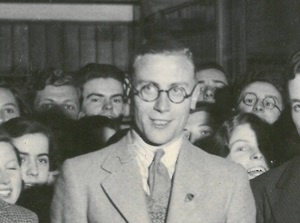
James "Jimmy" Mackay in 1936
The student show has its roots in the decision in 1920 to hold a Gala Week to raise money for Aberdeen hospitals. As part of the 1921 programme of events, a Mock Trial was held in the Debating Chamber in Marischal College, and having been deemed a success, a request was made by the Gala Week Committee to put on an annual locally-themed musical comedy show; thus in 1922 the first 'official' student show was held. Entitled 'Stella The Bajanella', the show was penned by Eric Linklater, at the time an undergraduate at the University. Linklater went on to become a successful and well-known author, even winning the Carnegie Medal from the Library Association in 1944 for the year's best children's book by a British subject, and also going on to serve as Rector of the University from 1945-48 (and authoring another student show while he was in the position, 1946’s ‘Meet the MacGregors’). The show's title is a reference to a student of the University - traditionally 'Bajan' was a term used to refer to a first year undergraduate at Aberdeen, and when women were admitted as students from the 1890s onwards, a female variant of the term was coined.
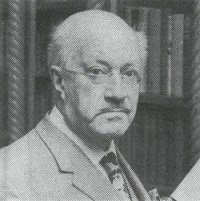
Eric Linklater
The original Stella the Bajanella was a medical student by the name of Stella Henriques who took the title role in an earlier revue of the same name held on the platform in the men's union. However, when the idea was expanded into a fully-fledged show in 1922, by her own admission Stella “hadn't a strong enough voice to sing, they realised that. I had to talk the songs and then the following year […] they got somebody with a better voice, so I was out of it.”
Up until now, the University possessed very little material directly pertaining to ‘Stella the Bajanella’. However, in the box of items forwarded to us by James Mackay's son was a carefully-labelled envelope containing two faded black and white photographs showing his aunt, Jean Mackay, who had played the title character. This led to a search of the archives, which brought to light a picture of the cast of the show lined up in costume on stage!
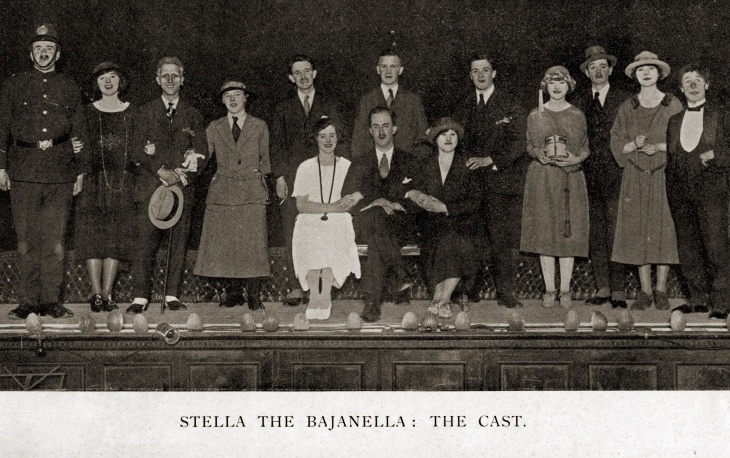
A brief recollection of the earliest shows was provided by George Harvey Rowntree in the souvenir programme of 1929:
"How or where or with whom exactly the idea of producing a musical comedy for Gala Week first originated I do not know. What I remember are the free and easy rehearsals in the Grammar School Hall. There "Stella the Bajanella," the first of the post-war musical shows, and the most famous in name still, was produced in 1922.
That year, and for a few years after, the plan worked upon was to start rehearsing a week before the date of production and to work intensively for the seven days left, and if intensity did not do all it was expected to do, everyone concerned trusted to luck to pull the show through on the first night. The chief collaborators in "Stella the Bajanella" were Mr. E. R. R. Linklater and Dr. John S. Taylor - the first wrote the "book," the other the "score." The tunes for "Stella" had pretty sentiment in some and plenty of "go" in others; but now both kinds, in the distance, have taken on a coating of sentiment. "Stella" was, as to style, a very free and easy show; "Rosemount Nights," the second production by the same collaborators, was tightened up as to stagecraft. Here, as in most of the musical comedies, there were songs by other hands than those of the main writers. The setting was more elaborate and also the orchestration. The "book" reached the dignity of print, and, I think, may still be had. [NOTE: Indeed, the book of the script can be found in the University’s Special Collections Centre bound in a volume with several other plays from the time, and reveals that the original production, apparently a direct sequel to 'Stella the Bajanella', again featured Jean Mackay playing the part of Stella.]
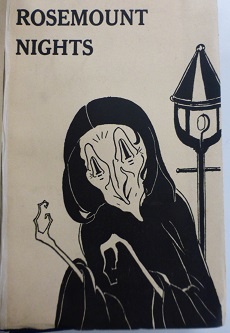

One of the best all-round shows was the third - "The Prince Appears." The music for this was written by Dr. A. F. Hyslop, and was of a delightfully skittish nature. There was a memorable character in this - an Indian servant of gigantic proportions, whose name was Loofah. His chief duty was to wield menacingly a huge scimitar, "Loofah, you may relax," became a Union catchword. Loofah never spoke a word until the last act, when the revealed Turra' accent and origin of the player brought down the house nightly.
A new author and a new composer appeared in 1925 with "One Exciting (K)night" - the knight, by the way, was according to his forbears, really a baronet, a slip of the author's which few noticed. Mr. David Landsborough Thomson was the author, and Mr. R. F. G. MacCallum, the University's pet syncopator of the time, the composer. The tunes were jazzy and melodious, and were sung for long after the production.
Finally came "The Witching Hour," of which, curiously, I have not much recollection : The author and composer were the same as in 1925. To the later musical comedies Mr Douglas Raitt contributed lyrics, music, and polished acting.
The four later comedies were produced in the Training Centre Hall, and year by year the audiences increased - the Gala Week Show became "the thing" to attend. They were witty affairs, these musical comedies; the music was tuneful and sparkling, and the acting often reached a high level of finish - wonderful all, considering the time given to rehearsal and writing. The actors, authors, and composers rested least on the seventh day - the Sunday before the Monday on which production was due, and at times seemed impossible. It was the usual thing for lyrics to be written and composed on the Sunday, or even sometime during the Monday - but they were put across. If, then, the Monday's performance seemed in comparison to have no relation to those of Tuesday and the other nights, that was not to be wondered at. But there were always good spirits and fun at rehearsals and optimism - more optimism than anything else. They were simple shows in production - and almost like improvisations - but they won through and won good opinions."

The first "souvies": 1928-1931
In 1927 the show changed to a revue format, entitled 'Northern Lights', and this title and format was retained for the next five shows, and supplemented by 1932's slightly smaller scale 'Aurora Borealis'. Significant developments in this period of time included the relocation of the show to its present-day home in His Majesty's Theatre in 1929 as well as the issue of the first show Souvenir Programme in 1927. The "souvie", as it became lovingly known, was sold to raise additional funds for charity and quickly became a traditional part of show culture, a position it still retains today. Indeed, the in-depth and humorous programmes give us most of the knowledge and pictures that we still have about the various shows through decades. Sadly, the very first programme is missing from the University's show archive; however a copy of almost every year's from 1928 onwards can be found.

The "Micros" Chorus from 1928's Opening Number
Following a slimmed-down revue show entitled 'Aurora Borealis' in 1932 which was held at the Beach Pavilion (uncertain finances having left the future of His Majesty’s Theatre in doubt), 1933 saw the show return to HMT in the form of 'Town and Gown', by far the most ambitious student show yet. A cast of one hundred and twenty presented a spectacular history of the University of Aberdeen, part fact and part fiction, starting with the delivery to Bishop Elphinstone of the Papal Bull that founded the University in 1495, through the visit of King James V in 1541, Earl Marischal's foundation of Marischal College in 1593, the Jacobite Rebellion, the (probably) mythical death of the Sacrist Downie, the amalgamation of the two colleges into the University of Aberdeen, the coming of women to the University, the foundation of Gala Week and a selection of the best songs from previous shows. The show was so successful that a book of the script was published and upon the show’s conclusion the University's Principal immediately demanded that the entire show be repeated the next year for the conference of the British Association for the Advancement of Science which was held in the city in 1934, and so it was.
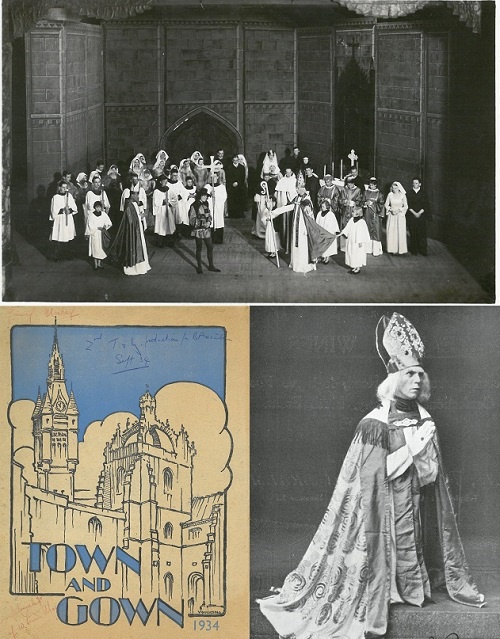
Town and Gown (1933-34): Cast, "souvie" cover and Keith Conn as Bishop Elphinstone
The follow-up to 'Town and Gown' was 1935’s 'Caravanella', an updated take on 'Cinderella' in which the heroine, a performer in a travelling show, ultimately discovers she is the heiress to a large Scottish estate. Penned by George Rowntree Harvey, it was one of the only shows for which Special Collections did not previously hold the souvenir programme; however, amongst the material sent to us by Mr Mackay was a folder containing scripts and the programme for this show, allowing us to plug one of the very few remaining gaps in the “souvie” collection. We also received the script for 1937's 'That's What You Think!' in which the students of a University in the North East of Scotland defeat a plot to sell off the institution and turn it into a hotel! 'Caravanella' is notable for being the first show for which any kind of audio record exists, as a selection of the songs were recorded beforehand by Jimmy Ross at the HMV studios in London for a 78 record which was sold in the theatre’s foyer. This was repeated for the 1936 show 'Out for The Count' and 1938’s time-travel themed 'Beating Time'; all three records can be found in the University's Special Collections Centre.
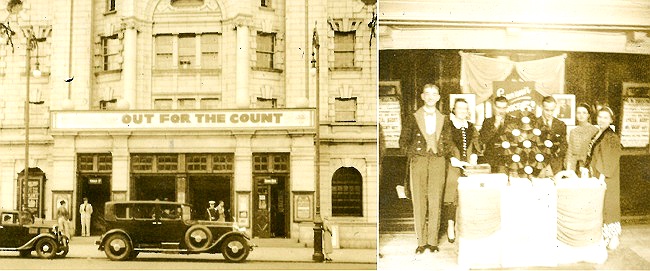
'Out For The Count' (1936): Theatre frontage & records on sale in the foyer
Of the material we received from James Mackay’s son, one of the nicest items related to 'Out For The Count', in the form of a wonderful photograph album which has been lovingly compiled and carefully annotated in silver ink and serves as a unique visual record of a show that took place more than 80 years ago. Other material received includes hand-drawn colour depictions of certain scenes, original theatre posters, theatre programmes, good luck telegrams and various letters pertaining to every aspect of organising the show.
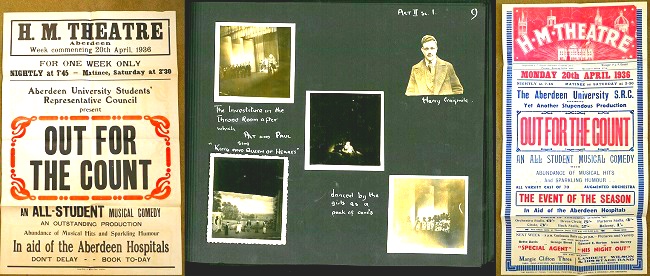
'Out For The Count' (1936): Posters and photo album
What really hits home when looking through all this early Student Show material is how quickly it went from an amateurish production held in a school hall to a huge and impressive event with a huge cast taking place in the city’s main theatre, with souvenir records and programmes and people queuing up for hours to get tickets. It’s remarkable that it remains such a popular event even now, selling out night after night and raising thousands of pounds for good causes in the process. Fashions may have changed, but all the key elements of the show remain intact, the local aspect and sharp scripts giving it a unique element that ensures that it continues to thrive year after year. Of course, the end of the 1930s and the onset of World War II brought with it a certain set of circumstances that were reflected in the show, both behind and in front of the curtain. But as they say, "the show must go on", and on it went. Perhaps we’ll have a look at the 1940s in a future article.
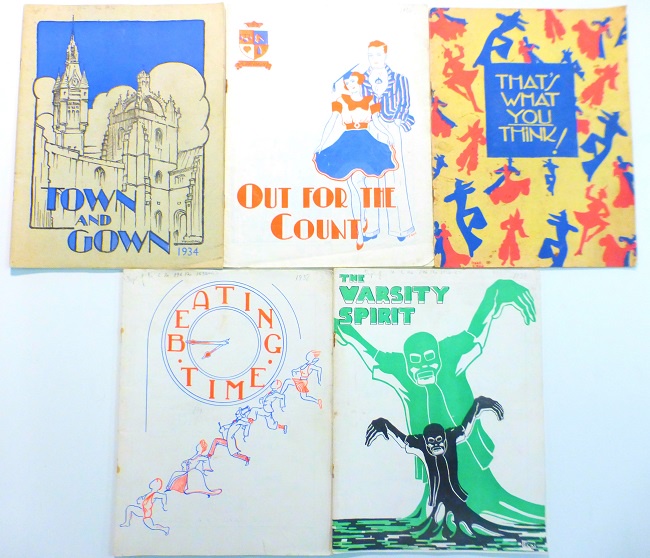
Assorted "souvies" from the 1930s
Were you in a Student Show during your time at the University of Aberdeen? If you'd like to share your experiences then we'd love to hear from you. Please email us at alumni@abdn.ac.uk.


